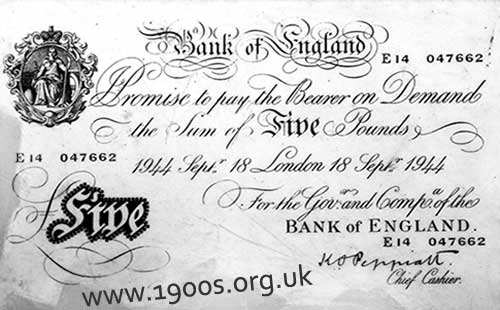Banknotes in 20th century UK

For most of the 20th century - until 1983 - there was no pound coin in Britain, and the 50p coin was phased in during the 1960s. Before that there were paper bank notes. This page explains why bank notes disappeared in favour of coins and why there were a number of different designs on them.
____
By the webmaster, based on living and working with pre-decimal currency over many years and with firsthand contributions
Inflation and why smaller banknotes were phased out
Pound notes and indeed ten shilling notes had huge buying power in the early 20th century. For example an entire family could be fed and housed - albeit in the London slums - for just a pound a week.
Even when I was growing up in the late 1940s, I heard of a young woman starting work at the wage of £3 a week. My grandmother was horrified that anyone so young and with no qualifications could possibly earn so much.
Inflation was a fact of life, and of course still is. The end of the pound note was due to inflation. As the century progressed. it became clear that the pound and ten shillings were no longer a great deal of money for ordinary people, so it was sensible to replace them with a more durable and easily handled coins.
There is more on this site on the buying power of the old money. Just put inflation into the search box on the home page.
Paper money in circulation in the 1940s and 50s
The only notes that I ever saw as a child were pound notes and ten shilling notes. They could readily be seen in shops as customers handed over money and received their change.
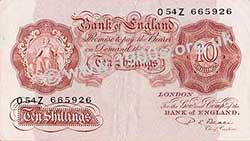
Ten shilling note of the sort that I remember in the 1940s.
The ten shilling note continued to be printed until 1969 when the replacement 50p coin was gradually introduced. It ceased to be legal tender on 15th February 1971, the day when the UK went over entirely to decimal money. That day was known as D-Day - D for decimal - the second D-Day, not to be confused with the first one D-Day when the Allies invaded to liberate Europe from German occupation in World War Two.
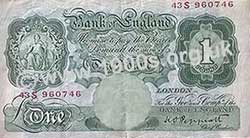
Pound note of the sort that I remember in the 1940s.
There were other versions since, but all were phased out by 1983 and replaced by the £1 coin.
1944 £5 note photographed in Tylford Rural Life Centre
The bank note in this photo and others online show that these bank notes were still being printed during the war, although I never saw any of them because £5 was such a huge amount of money then.
These five pound notes were extremely elegant with black scrolls on a white background and they were slightly larger than the pound notes.
Paper money in Scotland
Scottish and Irish banknotes
contributed by Douglas Adam
English and Welsh banknotes, issued by the Bank of England, were little seen in Scotland - with the one exception of the 10 shilling note. Scottish banks (and Irish too) had royal charters to issue their own notes. These notes were unpopular in England probably due to their unfamiliarity and variety. As a result of bank amalgamations, there were numerous different notes in circulation when I was young. (I was born in 1935.) Examples were British Linen Bank, Clydesdale Bank. North of Scotland Bank, Clydesdale and North of Scotland Bank, Union Bank of Scotland, Bank of Scotland, Royal Bank of Scotland, Commercial Bank of Scotland, National Commercial Bank of Scotland. These are those I remember. There may have been more and probably were before then.
Sizes and thicknesses of banknotes
All the various pound notes were about the same size, with 10 shilling notes slightly smaller and Scottish denominations larger. The Bank of England 'fivers' and higher were much larger and had to be double-folded to fit into a wallet. This became a problem when inflation brought them into common use, resulting in size reduction along with colour printing. Ease of forgery of the simple black on white also, no doubt, played a part in the change.
I understand that blind people could tell the denomination of a note by butting it against the cleft between the ring and middle fingers to detect its thickness.
When the pound coin replaced the banknote many people preferred to use the Scottish notes rather than the coins.
1939 man's wallet with markings for banknotes
The wallet shown in the following image was my grandfather's. I found it with his effects, dated 1939. It is larger than today's wallets and the markings on it show that it was designed to accommodate at least one of the large £5 notes. For several decades after 1939, men's wallets would have had similar slots, also with slots like these for pound notes and 10 shilling notes.
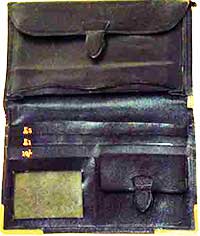
Leather wallet showing the labelling for £5, £1 and 10 shilling notes.
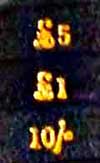
Detail of the £5, £1 and 10 shilling markings.
The single, no-longer transparent, pocket was probably intended for a train season ticket, as credit cards were years away.
The design changes of banknotes
New designs of banknotes and coins follow the changing face of the monarch or honour a particular person by incorporating their image into the design.
Technology also plays its part through the development of new more robust or cheaper materials for bank notes. Hence polymer notes which I saw in Australia years before they appeared in the UK.
Changes due to the pandemic
The Covid-19 pandemic accelerated the changes that had been developing slowly for some time. In order not to spread the virus, ways to transfer money without having to handle cash or bank notes were accelerated. Shops accepted contactless credit card payment for increasing amounts and cheques for sending money were effectively phased out in favour of bank transfers and online credit card payment.
| sources | webmaster | contact |
Text and images are copyright
If you can add anything to this page or provide a photo, please contact me.


